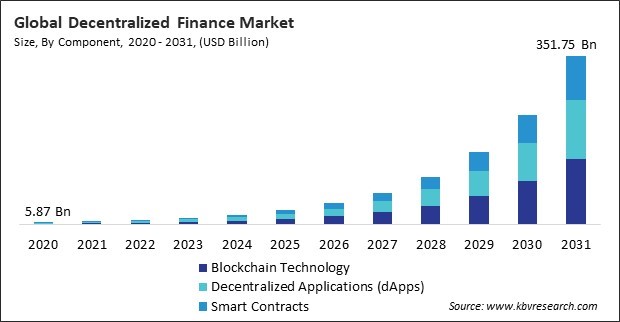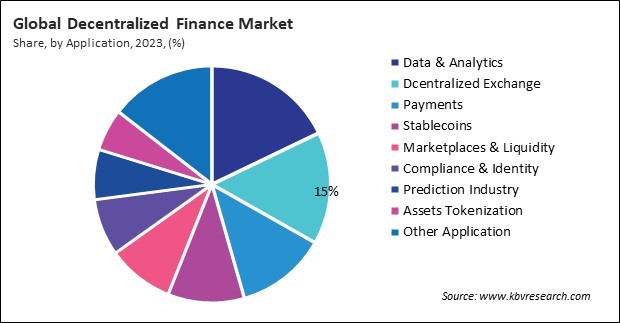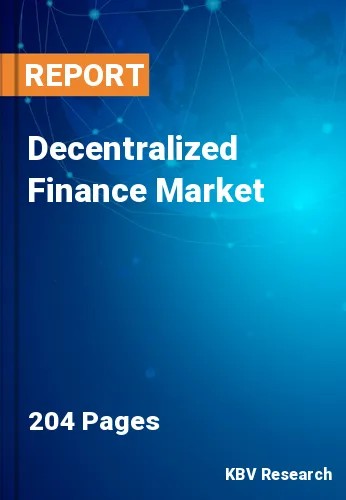“Global Decentralized Finance Market to reach a market value of USD 351.75 Billion by 2031 growing at a CAGR of 48.9%”
The Global Decentralized Finance Market size is expected to reach $351.75 billion by 2031, rising at a market growth of 48.9% CAGR during the forecast period.
DeFi payment systems allow users to conduct borderless, low-cost, and instant financial transactions, making them an attractive alternative to traditional banking systems. The growth of merchant adoption, peer-to-peer (P2P) payment platforms, and blockchain-based remittances played a crucial role in expanding this segment. Furthermore, the rise of crypto debit cards, digital wallets, and DeFi lending protocols enabled users to seamlessly spend and borrow digital assets, fueling market demand. The integration of stablecoins into payment systems also enhanced transaction stability and reduced volatility, contributing to the segment’s strong performance. Thus, the payments segment witnessed 12% revenue share in the market in 2023.

Cryptocurrencies, including Bitcoin, Ethereum, and altcoins, provide a decentralized medium of exchange that operates outside the control of traditional financial institutions. However, DeFi takes this concept further by leveraging these digital assets to offer various financial services, such as lending, borrowing, staking, and trading without intermediaries. Hence, these factors will aid in the expansion of the market.
An additional profitable approach to generating passive income within the realm of decentralized finance is staking. This process involves users committing their assets to a blockchain network to facilitate transaction validation and enhance network security. Proof-of-Stake (PoS) and its variations, such as Delegated Proof-of-Stake (DPoS) and Liquid Staking, offer rewards to participants for supporting network operations.
However, many countries lack structured guidelines for DeFi, leading to uncertainty for businesses and investors alike. The absence of unified regulations creates challenges for DeFi projects in securing institutional investments and expanding into new markets. As a result, companies operating in the DeFi space face unpredictable legal environments, making long-term planning difficult. Hence, these factors may hamper the growth of the market.
Based on component, the market is classified into blockchain technology, decentralized applications (dApps), and smart contracts. The smart contracts segment procured 25% revenue share in the market in 2023. Smart contracts are self-executing digital agreements that automate financial transactions without intermediaries, making them a fundamental element of DeFi applications.

On the basis of application, the market is divided into assets tokenization, compliance & identity, marketplaces & liquidity, payments, data & analytics, decentralized exchange, prediction industry, stablecoins, and others. The stablecoins segment garnered 10% revenue share in the market in 2023. In the decentralized finance ecosystem, stablecoins—such as USDT, USDC, and DAI—are essential for transactions like lending, borrowing, trading, and remittances because they offer a dependable store of value as well as a medium of exchange.
Free Valuable Insights: Global Decentralized Finance Market size to reach USD 351.75 Billion by 2031
Region-wise, the market is analyzed across North America, Europe, Asia Pacific, and LAMEA. The Asia Pacific segment acquired 27% revenue share in the market in 2023. Countries such as China, India, South Korea, Japan, and Singapore have witnessed rapid growth in decentralized financial services, driven by increasing interest in crypto investments, digital payments, and blockchain-based applications.
| Report Attribute | Details |
|---|---|
| Market size value in 2023 | USD 15.17 Billion |
| Market size forecast in 2031 | USD 351.75 Billion |
| Base Year | 2023 |
| Historical Period | 2020 to 2022 |
| Forecast Period | 2024 to 2031 |
| Revenue Growth Rate | CAGR of 48.9% from 2024 to 2031 |
| Number of Pages | 204 |
| Number of Tables | 319 |
| Report coverage | Market Trends, Revenue Estimation and Forecast, Segmentation Analysis, Regional and Country Breakdown, Porter’s 5 Forces Analysis, Company Profiling, Companies Strategic Developments, SWOT Analysis, Winning Imperatives |
| Segments covered | Component, Application, Region |
| Country scope |
|
| Companies Included | Aave, Balancer Labs, Compound Labs, Inc., Badger DAO, Bancor, SushiSwap (Yearn Finance), MakerDao, Synthetix and Curve Finance |
By Component
By Application
By Geography
This Market size is expected to reach $351.75 billion by 2031.
Growth of Cryptocurrencies & Tokenization are driving the Market in coming years, however, Regulatory Uncertainty for DeFi-Related Activities Limiting Adoption restraints the growth of the Market.
Aave, Balancer Labs, Compound Labs, Inc., Badger DAO, Bancor, SushiSwap (Yearn Finance), MakerDao, Synthetix and Curve Finance
The expected CAGR of this Market is 48.9% from 2023 to 2031.
The Blockchain Technology segment is leading the Market by Component in 2023; thereby, achieving a market value of $137.93 billion by 2031.
The North America region dominated the Market by Region in 2023, and would continue to be a dominant market till 2031; thereby, achieving a market value of $124,732.3 million by 2031.
Our team of dedicated experts can provide you with attractive expansion opportunities for your business.

 Drivers
Drivers
 Restraints
Restraints
 Opportunities
Opportunities
 Challenges
Challenges
